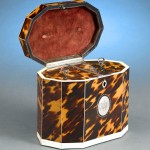No other practice evokes British sophistication and elegance quite like the drinking of tea. It is hard to believe that this now-common beverage was once an incredibly expensive commodity that could only be enjoyed by nobility and the social elite. These connoisseurs would soon demand elaborate and luxurious accoutrements to store and prepare this prized drink.
Tea was introduced to England from China sometime in the middle of the 17th century. It is believed that it was Catherine of Braganza, wife of King Charles II, who was responsible for bringing the tea habit to the country around 1660. The practice gained momentum and became an en vogue activity by the 18th century. The country’s respect for this drink is reflected in the ceremonial way in which it was stored, prepared, and drunk, and craftsmen of the period soon discovered a new avenue in which to exercise their skills–the creation of beautiful tea caddies.

 The rarest tea caddies were crafted of the most costly materials of the era, boasting stunning veneers of tortoiseshell and ivory, often with sterling silver mounts. This George III tea caddy is enveloped entirely in tortoiseshell, with ivory and silver detailing of exceptional quality. With its unique decagon shape, this caddy contains two interior compartments for holding different types of tea leaves. Tea connoisseurship developed into something of an art form, and accordingly, more than one type of tea was necessary for refined palettes. Double chests such as this could hold two types of leaves, usually one green and one black variety that could be custom-blended to achieve the desired flavor. Incredibly rare indeed, this original pair of George III ivory tea caddies are encased in creamy white ivory, highlighted by tortoiseshell veneers and silver accents.
The rarest tea caddies were crafted of the most costly materials of the era, boasting stunning veneers of tortoiseshell and ivory, often with sterling silver mounts. This George III tea caddy is enveloped entirely in tortoiseshell, with ivory and silver detailing of exceptional quality. With its unique decagon shape, this caddy contains two interior compartments for holding different types of tea leaves. Tea connoisseurship developed into something of an art form, and accordingly, more than one type of tea was necessary for refined palettes. Double chests such as this could hold two types of leaves, usually one green and one black variety that could be custom-blended to achieve the desired flavor. Incredibly rare indeed, this original pair of George III ivory tea caddies are encased in creamy white ivory, highlighted by tortoiseshell veneers and silver accents.
Beloved for its flavorful, exotic, and even medicinal qualities, few would have guessed that the importation of a simple plant would have give rise to over two centuries of culture and decorative art.






